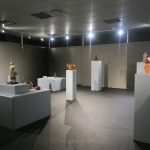 Form and Function
Form and Function

William Humphreys Art Gallery, Permanent Collection
Untitled: the Dumisani Mabaso Retrospective is a retrospective exhibition of work by the acclaimed South African artist, Dumisani Abraham Mabaso, that resulted from consultations with the Mabaso family about the importance of aggregating the late Mabaso’s contribution to South African art. This follows the establishment of the Mabaso Archive at the William Humphreys Art Gallery in Kimberley.

Mabaso Portrait – The Artists’ Press
Mabaso (1955-2013), was a South African painter, master-printmaker and jazz musician, whose work tenderly explored individual-centred social realism, resistance and spirituality with a jazz-like zest for improvisation. This retrospective aims to give a thematic overview of important periods in the artist’s career, focusing on social realism, resistance art, jazz and spirituality as key themes in his work.
Mabaso’s critical take on society draws your attention to the conditions of the disenfranchised and disaffected, empathetically engaging with his subjects without compromising his astute criticism of the social structures that breed the enduring poverty and marginalisation the working class and poor endure. His use of social realism creates awareness of the numerous struggles faced by residents of townships and political matters that are responsible for despair and harsh realities in South Africa.
By means of artistic styles, such as abstractionism and expressionism, he raises awareness of the deteriorating conditions in South Africa, particularly in the townships. By exposing the realities of the hardships and concerns of people living in poverty, his works put into question the injustice that was, and is still going.

Queen Modjadji’s Shrine, 2013 – Dumisani Mabaso
Mabaso was particularly outspoken and critical regarding political leaders and political parties such as the African National Congress (ANC) and their former president, Jacob Zuma. This is expressed in works like Untitled, 2010, in which Mabaso depicts the chaos and disruption he associated with these two entities.
This socially aware and responsive perspective continued way beyond the period heralded as the apex of Resistance Art in South Africa, and Mabaso like many prominent resistance artists of the 80’s and 90’s continued to speak truth to the oppressive powers of the apartheid regime. In doing so, he unveils political truths of the apartheid system and his frustration at the post 1994 ANC government actions that delayed the emancipation for the workers and the poor.
Towards the late 90’s, Mabaso started to move away from the social realism of his earlier work and increasingly began to depict highly emotive imaginings of freedom, true social unity and emancipation. The hope that sustained generations through their struggles toward equality is palpable in artworks like Rainbow Nation, which depict abstracted figures stretching upwards as a means to fight for life and a better future. Mabaso’s works visualise the aim at a better socio-economic culture throughout the country, while urging for the inclusion of once marginalised individuals in attempts to mandate the realisation of a more transformed South Africa.

Untitled, 2010 – Dumisani Mabaso
The dexterity of the concept of emancipation as applicable to both the political and spiritual was not lost on Mabaso, who for the most part of his career explored spiritual theme, often in a magically realistic fashion as seen in his earlier evocations of African rainmakers and ritual masks. Towards the later part of his life, in the face of his declining life, spirituality as theme becomes more dominant.
Symbolic and sacred subjects such as ancestral shrines move to the fore of his attention, while stylistically the transcendental affect in Sufi rhythms collide with the African polyrhythms that have become synonymous with Jazz. This was partially fuelled by his conversion to Islam in later life, however throughout his career as a visual artist, he draws clear parallels between composition in jazz and composition in visual art.

Rainbow Nation, 2012 – Dumisani Mabaso
As a jazz musician, Mabaso would often be called onto the stage by other performers to join in on the performance. In most of his jazz-inspired monotypes, Mabaso created purely nonrepresentational imagery; synthesizing the experiences of music and nature. He frequently listened to jazz music by artists such as Jaco Pastorius, and Babsy Mlangeni while he created his artworks. He rendered nature by using a range of colours, repetitive gestural strokes, and shapes to give a sense of unfolding parallel music. While working on his prints in the studio, the artist entered a timeless space. A space where he deeply connected with time and the rhythms of matter through his vivid colours and folkloric themes.
Mabaso’s drawings, prints and paintings are translations of his subjective experience and observations of his life, whereabouts, music, politics and power. His work is humanistic, individualized and soulfully in love with South Africa and her people.
Untitled: the Dumisani Mabaso Retrospective: is supported by the Klein Karroo National Arts Festival and was curated by M.C. Roodt for the William Humphreys Art Gallery in partnership with the University of Johannesburg. The KKNK 2023 Visual Art Exhibitions is supported by Absa.
Text Authorship Titles and Credits:
Edited: M.C. Roodt
Authors: Sinazo Gamedala, Carolienne Jansen van Rensburg, M.C. Roodt & Tlotlo Sereisho.
Photography Credit: Jessica Staple